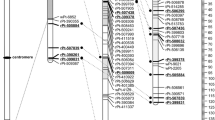Abstract
The genetic control of plant height has been studied in hexaploid forms of triticale (2n = 42) with genomic structure AABBRR. Thirty-four specimens from the world collection of triticale at the Vavilov All-Russia Research Institute of Plant Breeding with plant heights from 70 to 180 cm have been used in the study. The hybrid analysis of the first, second, and third generations, as well as backcross offsprings, has demonstrated that the given trait is characterized by different modes of inheritance: dominance of dwarfism, dominance of tallness, and intermediate inheritance. It has been found that triticale cultivars of middle and large height differ from short ones in alleles of one or two major genes.
Similar content being viewed by others
References
Smirnov, V.G. and Sosnikhina, S.P., Genetika rzhi (Rye Genetics), Leningrad: Leningr. Gos. Univ., 1984.
Merezhko, A.F., Pisareva, L.A., and Prilyuk, L.V., Genetic Control of Plant Height in Wheat, Genetika (Moscow), 1986, vol. 22, no. 5, pp. 725–732.
Kobylyanskii, V.D., Rozh’: Geneticheskie osnovy selektsii (Rye: Genetic Basis of Breeding), Moscow: Kolos, 1982.
Al’derov, A.A., Genetika korotkostebel’nosti tetraploidnykh pshenits (Genetics of Dwarfishness in Tetraploid Wheats), St. Petersburg, 2001.
Pshenitsy mira: vidovoi sostav, dostizheniya selektsii, sovremennye problemy i iskhodnyi material (Wheats of the World: Species Composition, Breeding Achievements, Current Problems and Original Material), Dorofeev, V.F., Yakubtsiner, M.M., Rudenko, M.I., et al., Eds., Leningrad: Agropromizdat, 1987.
Oehler, E., Untersuchungen uber Ansatzverhaltnisse, Morfologie und Fertilitat bei Weizen-Roggen-Bastarde, Z. Zuchtung A, 1931, vol. 16, pp. 1–4.
Muntzing, A., Triticale: Results and Problems, Berlin, 1979.
Kiss, A. and Redei, G., Experiments to Produce Rye-Wheat (Triticale), Acta Agr., Acad. Sci. Hung., 1953, vol. 3, no. 3, pp. 257–276.
Mogileva, V.I., Breeding Octoploid Triticum triticale, Genetika a slechteni, 1972, vol. 8, no. 3, pp. 161–170.
Gordei, I.A., Tritikale: Geneticheskie osnovy sozdaniya (Triticale: Genetic Bases of Construction), Minsk: Navuka i Tekhnika, 1992.
Tikhenko, N.D., Tsvetkova, N.V., and Voilokov, A.V., The Effect of Parental Genotypes of Rye Line on the Development of Quantitative Traits in Primary Octoploid Triticale: Plant Height, Rus. J. Genet. 2003, vol. 39, no. 1, pp. 64–69.
Shevchenko, V.E. and Karpachev, V.V., Inheritance of Plant Height upon Hybridization of Triticale, Dokl. Vses. Akad. S-kh. Nauk, 1983, no. 9, pp. 4–6.
Rekhmetulin, R.M., Inheritance of Dwarfishness in Triticale, Tr. Prikl. Bot., Genet. Selekts., 1984, vol. 85, pp. 61–66.
Rekhmetulin, R.M., Inheritance of Plant Height in Hybrids of Winter Triticale, Tr. Prik. Bot., Genet. Selekts., 1985, vol. 98, pp. 99–104.
Shevchenko, V.E. and Goncharov, S.V., Introgression of Dominant Low Plant Height of Rye into the Triticale Genome, Vestn. S-kh. Nauki, 1990, no. 10, pp. 29–33.
Börner, A. and Plaschke, J., Dwarfing Genes of Wheat and Rye and Their Expression in Triticale, Triticale: Today and Tomorrow. Developments in Plant Breeding, Guedes-Pinto, H., Darvey, N., and Carnide, V.P., Eds., Netherlands: Kluwer Academic, 1996, pp. 275–280.
Tarkowski, Cz., Gruschecka, D., Bichta, I., and Kowalczyk, K., Transfer of Genes Rht1, Rht2 and Rht3 from Wheat to Triticale, Triticale: Today and Tomorrow. Developments in Plant Breeding, Guedes-Pinto, H., Darvey, N., and Carnide, V.P., Eds., Netherlands: Kluwer Academic, 1996, vol. 5, pp. 281–288.
Wolski, T. and Gryka, J., Semidwarf Winter Triticale, Triticale: Today and Tomorrow. Developments in Plant Breeding, Guedes-Pinto, H., Darvey, N., and Carnide, V.P., Eds., Netherlands: Kluwer Academic, 1996, pp. 588–590.
Shevchenko, V.E. and Goncharov, S.V., Interaction of Nonallelic Dwarfing Genes in Triticale, Dokl. Ross. Akad. S-kh. Nauk, 1997, no. 3, pp. 3–4.
Pojmaj, M.S. and Szolkowski, A., Genetic Analysis of Plant Height in Winter Triticale, Vortr. Pflanzenzucht., 2000, vol. 47, p. 7.
Kurkiev, K.U., Intraspecific Diversity of Hexaploid Triticale with Respect to Plant Height, Tr. Prikl. Bot., Genet. Selekts., 2000, vol. 158, pp. 40–44.
Kurkiev, U.K., Topical Problems in Triticale Breeding and Generation of New Initial Material, Tr. Prikl. Bot., Genet. Selekts., 2000, vol. 158, pp. 44–58.
Beil, G.M. and Atkins, R.E., Inheritance of Quantitative Characters in Grain Sorghum, Jowa State. J. Sci., 1965, vol. 39, no. 3, p. 52.
Dospekhov, B.A., Metodika polevogo opyta (Methods of Field Experiments), Moscow: Kolos, 1979.
Author information
Authors and Affiliations
Additional information
Original Russian Text © K.U. Kurkiev, U.K. Kurkiev, A.A. Al’derov, 2006, published in Genetika, 2006, Vol. 42, No. 3, pp. 369–376.
Rights and permissions
About this article
Cite this article
Kurkiev, K.U., Kurkiev, U.K. & Al’derov, A.A. Genetic control of dwarfism in hexaploid triticale (Triticosecale wittm.). Russ J Genet 42, 286–293 (2006). https://doi.org/10.1134/S1022795406030082
Received:
Issue Date:
DOI: https://doi.org/10.1134/S1022795406030082




